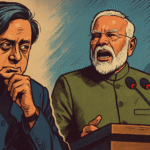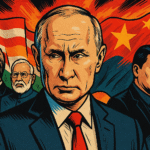Imagine a cricket match where both teams decide to share their best players. That’s exactly what’s happening between India and the UK—but instead of batsmen and bowlers, we’re talking about basmati rice and British whisky.
- 🚄 What Is the India UK FTA?
- 🛍️ India’s Gains: From Sarees to Software
- 1. Zero Duty on 99% of Indian Goods
- 2. Better Mobility for Professionals
- 3. Fewer Social Security Payments
- 🛍️ What’s in It for the UK?
- 🧁 Everyday Impact: What Will Get Cheaper?
- 🌾 Farmers & Factories: The Real Winners?
- 📉 But Wait—What About Indian Businesses?
- ⚖️ Trade and Gender Chapters Included
- 📈 Timeline & Trade Growth
- 🗳️ Not So Fast: What’s Next?
- 💬 Final Thoughts: A Historic Step with a Long Track
After three years of negotiations, chai-fuelled Zoom calls, and plenty of paperwork, India and the United Kingdom have finally signed an FTA—that’s a Free Trade Agreement, not a “Fancy Tea Arrangement,” though a cup of Darjeeling might still be involved.
This landmark India UK FTA is set to double trade between the two countries, aiming to cross $100 billion by 2030. But what does that mean for you, me, and the average mango-loving Indian shopper?
Let’s decode the trade tango in plain English—with a pinch of wit, a dash of data, and a generous helping of common sense.
🚄 What Is the India UK FTA?
The India UK FTA, officially known as the Comprehensive Economic and Trade Agreement (CETA), is an economic handshake between two old friends. Think of it as a deal where both countries agree to lower taxes (called tariffs) on products they buy from each other.
So, fewer duties on whisky, wool, and cars from Britain. And fewer restrictions on Indian gems, garments, and gobi.
It’s a win-win if done right.
🛍️ India’s Gains: From Sarees to Software
Let’s first peek into India’s shopping basket of benefits:
1. Zero Duty on 99% of Indian Goods
Almost everything India exports to the UK—from leather bags to laddus—gets duty-free access. That’s a huge boost for labour-intensive sectors like:
- Textiles
- Leather
- Gems and jewellery
- Marine products
- Agriculture
- Ayurvedic goods
- Engineering & electronics
- Pharma and chemicals
So, your cousin in Birmingham can now buy a Banarasi saree or handmade Kolhapuri chappals without paying through the nose.
2. Better Mobility for Professionals
Indian professionals—teachers, chefs, musicians, IT engineers—will get easier access to the UK job market. That’s more curry in the Queen’s kitchen and more ragas in Royal Albert Hall.
3. Fewer Social Security Payments
The deal allows 75,000 Indian workers to skip the social security contribution in the UK for 3 years. That’s extra pounds in their pockets (and perhaps a few extra laddus too).
🛍️ What’s in It for the UK?
Don’t worry, the Brits aren’t walking away empty-handed. The India UK FTA has a few sweet deals for them too:
1. Reduced Tariffs on 90% of UK Products
India will lower duties on:
- Scotch whisky
- British gin
- Luxury cars & EVs
- High-end fashion
- Confectionery and biscuits
So yes, your imported shortbread might get cheaper.
2. Tariff Slashes on Scotch
Indian tariffs on whisky will drop from 150% to 75% initially, and then go down to 30% over 10 years. The price of your favorite dram might finally stop being dram-atically high.
3. Luxury Cars Roll In
Under a new quota, duties on British luxury automobiles may reduce significantly. Jaguar fans, rev your engines!
🧁 Everyday Impact: What Will Get Cheaper?
Here’s your “shopping list” of items likely to see price drops:
- Scotch whisky and gin
- EVs and luxury cars
- Chocolate, soft drinks
- Biscuits, crisps, and cheese
- Premium skincare
- Branded sports gear
- British baby formula
- And of course, non-alcoholic beer (yes, that’s a thing)
🌾 Farmers & Factories: The Real Winners?
This trade pact isn’t just about fancy food and imported handbags. It’s about economic upliftment.
For Indian Farmers:
- UK will import more basmati rice, mangoes, fresh and frozen seafood.
- Indian agro-products will find newer, higher-paying markets.
For Indian MSMEs:
- Simpler export procedures.
- Single-window clearance for Indian exporters.
- IPR protection for geographical indicators like Kolhapuri chappal, Kanjeevaram sarees, and Bikaneri bhujia.
India’s goods are ready to dazzle British shelves.
📉 But Wait—What About Indian Businesses?
Yes, there’s a flip side too.
British products will now face lower duties in India, which may increase competition for local Indian brands.
- Indian distillers will face heat from imported whisky.
- Toy manufacturers might lose some market share to UK products.
- Automobile makers will face luxury competition.
Still, competition often leads to better quality, lower prices, and more innovation.
⚖️ Trade and Gender Chapters Included
For the first time ever, a trade agreement signed by India includes chapters on:
- Gender equality
- Labor standards
- Sustainable development
So, the India UK FTA isn’t just about numbers. It’s about inclusive trade, where everyone gets a fair seat at the table.
📈 Timeline & Trade Growth
Check out the numbers:
| Year | Exports (in $ billion) | Imports (in $ billion) |
|---|---|---|
| 2022–23 | 11 | 9 |
| 2023–24 | 13 | 8 |
| 2024–25 | 16 | 6 |
Clearly, the trade is tilting in India’s favour—and it’s only expected to rise.
🗳️ Not So Fast: What’s Next?
Before you break out your Union Jack kurta, here’s a heads-up.
The agreement still needs to be:
- Approved by the British Parliament.
- Go through legal and bureaucratic processing.
- Implemented gradually—some benefits will take years to roll out fully.
So, while the agreement is signed, sealed, and handshaked—it’s not quite delivered. Yet.
💬 Final Thoughts: A Historic Step with a Long Track
The India UK FTA isn’t just a trade deal. It’s a cultural, political, and economic bridge between two diverse democracies.
It gives India a stronger voice on the global stage.
It helps the UK diversify trade beyond Europe.
And most importantly—it lets Indian mangoes and masalas find new fans in British households.
Will everything go perfectly? Probably not.
But in a world full of walls, this is a bridge worth celebrating.












